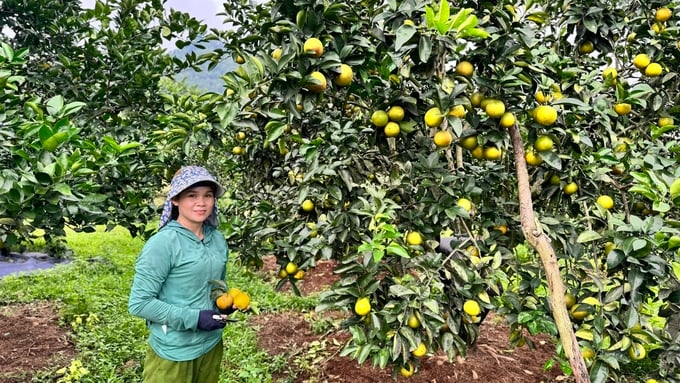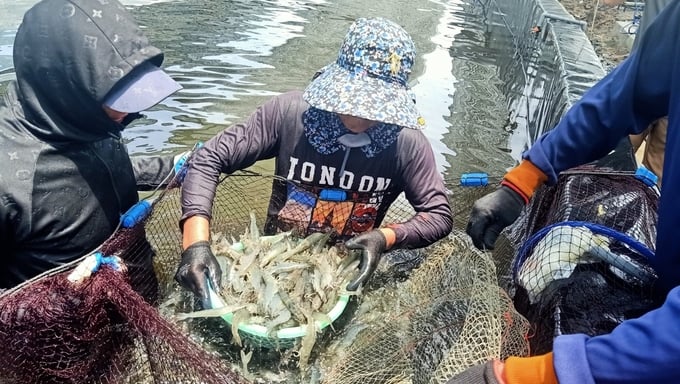November 27, 2025 | 17:42 GMT +7
November 27, 2025 | 17:42 GMT +7
Hotline: 0913.378.918
November 27, 2025 | 17:42 GMT +7
Hotline: 0913.378.918
Many farmers in Ha Tinh province have boldly invested in various circular agricultural production models, and enjoyed significant economic and environmental benefits.
In response to the increasing costs of agricultural input and livestock feed, circular agriculture emerges as a solution to reduce expenses and environmental pollution in livestock production. The integrated farm covering over 3 hectares owned by Mr. Tran Danh Giap's family in Dong Ly Nam village, Cam Binh commune, Cam Xuyen town, Ha Tinh province, is a prominent example.

Mr. Tran Danh Giap using waste from livestock production to raise earthworms as feed for fish, snails, and frogs. Photo: Anh Nguyet.
Mr. Giap shared: "My family began investing in farm development in 2017. However, due to limited experience and capital, we initially focused on small-scale production. After researching various information channels, I was determined to diversify our mode of livestock production, and develop towards a closed-loop integrated farm. To date, the farm is developing steadily and effectively, with an annual income of over 1 billion Vietnamese dong."
After recognizing the profitability and relatively low maintenance of crossbred cattle, Mr. Giap opted to engage in their production. From an initial 5 Zebu cows for breeding, his family's herd has expanded to a total of 16 heads, including 9 female cows for breeding. As a result, Mr. Giap earns approximately 200 million Vietnamese dong from the sale of breeding stock every year.
In order to maintain a stable food source for the cattle without incurring excessive costs, he utilized over 2,000 square meters of land around the ponds to cultivate VA06 grass, providing shade for the ponds and serving as cattle feed. Subsequently, he collects and ferments livestock waste with beneficial microorganisms for 2 to 3 days, and uses the mixture to feed earthworms, which will be used as feed for fish, snails, and frogs. The organic biofertilizer produced from the earthworms' waste is used to fertilize grass and fruit trees. The grass will subsequently become feed for the cattle.
This circular organic farming method allows him to maximize waste utilization, reduce feed expenses, improve production efficiency, and contribute to environmental protection. As a result, Mr. Giap's family farm maintains a stable development trajectory, despite fluctuating market prices.

The organic orange farm operated by the Gia Phuc Agricultural Cooperative. Photo: Anh Nguyet.
The 35-hectare farm operated by the Gia Phuc Agricultural Cooperative in Dat Do village, Thuong Nga commune, Can Loc district, Ha Tinh province, engages in the organic production of over 5,000 pomelo trees and 3,500 orange trees. Mr. Le Van Hai, Director of the Gia Phuc Agricultural Cooperative, shared: "By utilizing waste from 1,200 sows, we have raised earthworms to produce fertilizer for the organic production of orange and pomelo. Earthworm waste is a natural organic fertilizer, rich in nutrients and a diverse microbial ecosystem, suitable for all types of crops.”
Drawing from real-world production practices, earthworm cultivation can be regarded as a model that produces dual benefits. This is a closed-loop livestock production model that not only solves environmental pollution caused by livestock waste, but also generates high-nutrient feed for animals, thereby providing significant economic value to farmers. Earthworm waste is considered a highly beneficial source of organic fertilizer for crops and soil. As a result, this model is suitable for the current global trend of developing organic, circular, ecological, and sustainable agriculture.
Circular livestock production and circular agriculture as a whole, represent sustainable development directions which are actively applied by the government, specialized agencies, and residents of Ha Tinh province.
With support from the Ha Tinh province's Agricultural Extension Center, a VietGAP-compliant, circular pig farming model was implemented on a scale of 50 pigs at Mr. Hoang Van Thai's household in Ky Son village, Thach Dai commune, Thach Ha district. By applying farming techniques on a biological bedding base, using safe feed without antibiotics, growth hormones, chemical preservatives, and prohibited substances, the family's pigs have exhibited exceptional growth with reduced environmental pollution.

VietGAP-compliant pig farming model employing biological bedding at Mr. Hoang Van Thai's household. Photo: Anh Nguyet.
After four months, the pigs reach an average weight of 90 to 95 kilograms per head, with prices ranging from 59,000 to 60,000 Vietnamese dong per kilogram, which is higher than that of traditionally farmed pig by 4,000 to 5,000 Vietnamese dong per kilogram. This model not only brings high economic efficiency, but also produces high-quality and safe meat products for consumers. "Raising pigs in a circular farming model helps reduce environmental pollution. The pig manure on the bedding is composted to fertilize crops, which help to reduce production costs."
An extensive range of circular technology models have also been actively applied by farmers within the aquacultural sector. The three-stage intensive shrimp farming model using microbial technology and circular water filtration by Mr. Duong Quoc Khanh in Thach Ha commune, Ha Tinh city is one of the notable examples. Despite complex weather and disease developments in aquaculture, Mr. Khanh has succeeded with shrimp yields reaching over 10 tons per hectare, and profits exceeding 600 million Vietnamse dong per crop.
The three-stage shrimp farming model includes one nursery stage and two rearing stages. Accordingly, the pond system is designed with three ponds including a nursery pond, a stage 1 rearing pond, and a stage 2 rearing pond. The ponds, which are either circular or square-shaped, have an area of 1,500 to 1,800 square meters. They are made of galvanized steel frames to prevent rust, and lined with HDPE tarpaulin. Farmers use microbial technology, bactericides, and algae to clean the ponds' environment.

Three-stage intensive shrimp farming model using microbiological technology and circulating water filtration by Mr. Duong Quoc Khanh. Photo: Anh Nguyet.
The model also utilizes the Recirculating Aquaculture System (RAS) - one of the most advanced shrimp farming technologies in Vietnam to date. The water, after being discharged from the shrimp ponds and filtered through a settling pond with an area of approximately 35 square meters, will be treated and completely purified before being recirculated back to the shrimp ponds through pipelines, forming a closed-loop system.
Mr. Khanh revealed: "This system brings multiple advantages in terms of water conservation, disease prevention, high survival rate for shrimp (at over 85%), multiple harvests per year (2 to 3 harvests), significantly higher productivity compared to that of traditional methods, enhanced quality of shrimp, and complete absence of environmental pollutants thanks to thorough treatment of waste, impurities, and bacteria in the water."
Mr. Nguyen Huu Ngoc, Deputy Director of the Ha Tinh province's Agricultural Extension Center, commented: "Agriculture is currently facing major challenges in terms of environmental pollution, particularly due to waste from livestock production, and underutilized or unrecycled agricultural by-products, resulting in significant wastage."
This raises the issue of finding solutions to develop agricultural production models towards circular economy, with a focus on organic and green agriculture, thereby protecting the health and safety of the people and the environment.
Within the last few years, in addition to the application of modern technical and technological advancements in production, the agriculture and rural development sector in Ha Tinh province has actively engaged in promoting, encouraging, supporting, and enhancing scientific and technical knowledge transfer to the community to develop agricultural production towards circular economy.
Translated by Nguyen Hai Long

(VAN) According to Mr. Vo Minh Thanh, Director of the Tay Ninh Department of Agriculture and Environment, Resolution 57 has created a new development pathway for the locality, shifting from traditional toward modern agriculture.
/2025/11/26/4909-2-154329_878.jpg)
(VAN) Pearl grouper farming in HDPE cages not only delivers economic efficiency but also contributes to protecting the environment, creating jobs, and promoting marine-based experiential tourism.

(VAN) The model of making a living under the forest canopy through the agroforestry system in Van Son commune, Bac Ninh province, is expected to generate an annual income of approximately VND 30 million/ha.

(VAN) Many enterprises in Can Tho are harnessing natural energy and reducing greenhouse gas emissions in their production processes, thereby contributing to the promotion of a sustainable green transition.
/2025/11/24/3536-2-112800_176.jpg)
(VAN) Dong Nai now has tens of thousands of hectares of forests certified for sustainable management, and this area will continue to be expanded in the coming period.

(VAN) Vinh Ha hamlet (Dai Xuyen commune, Hanoi) is shifting away from small-scale farming as households adopt bioscurity into their breeder chicken models.

(VAN) Heavy rains make aquatic species more vulnerable to disease. Proactive water management and high-tech systems help farmers prevent outbreaks and protect yields.